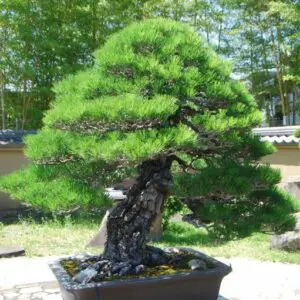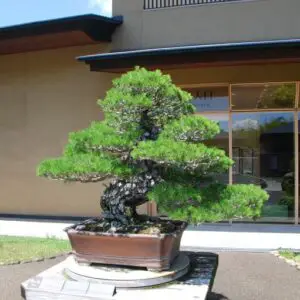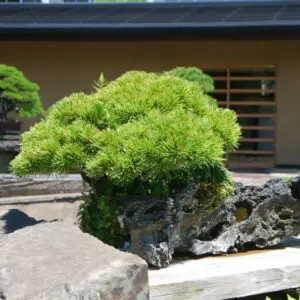Classic styles for pine bonsai trees include formal upright, informal upright, slanting, forest and bonsai-on-rock. Of these, informal upright and slanting styles are relatively easy to form and thus beginner friendly.
Introduction to pine bonsai styles
Pine trees are evergreen coniferous trees in the genus Pinus. They are one of the most popular bonsai species and are highly prized for their strong yet graceful beauty. A wide range of forms and styles can be achieved with them.
Though pine trees can be formed into almost all bonsai styles, you cannot forcibly shape the tree any way you want by wiring, pruning, or trimming the trunks and branches because those tree shapes will look very artificial.
Bonsai is an attempt to reflect in a pot the beauty of the tree that has grown in nature over many years. It is important to create a tree shape using the characteristics of the tree and expand them into an ideal style.
This post will help you understand the different options available and find the right style for the tree and you.
Classic styles for pine bonsai
Formal upright (Chokkan)

Formal upright style (black pine)
Formal upright (Chokkan) is a tree shape representing a single tree standing straight up in a field and is a typical coniferous tree form. It is the most undecorated form of bonsai and has always been admired for its simplicity.
It may be surprising to you but in-depth knowledge and experience are required to create a good formal upright style since its plain form easily reveals the flaws the trees may have and the mistakes you make when styling them.
Suitable materials for formal upright style are those with;
- multiple branches (especially the lowest branch is at one-third of the height of the tree),
- good surface roots (roots spread in all directions), and
- good Tachiagari (the lowest part of the trunk to the first branch from the bottom is straight without a curve).
Straight Tachiagari is crucial for this style because it is almost impossible to alter the form of the lowest part of the trunk, unlike the upper part which can be formed using wires. If you want a formal upright style for your pine tree, it is important to choose the right material from the beginning.
Slanting (Shakan)

Slanting style (black pine)
As the name suggests, slating (Shakan) has a trunk that leans on one side. The slanting style represents trees growing on steep mountain cliffs or rocky mountains, stretching their trunks in the direction of the light.
For the slanting style, a slightly curved trunk gives a more natural look than a straight trunk just slanting with an angle. This style requires multiple fine branches on the upper side, with several large (downward) branches on the lower side, creating an asymmetrical canopy.
Informal upright (Moyogi)

Informal upright style (black pine)
Informal upright (Moyogi) represents the trunk and branches falling and growing in different directions due to wind and other environmental influences. Informal upright is the most natural form of old pine tree in the wild and is often seen in the plain field.
In the informal upright style, the surface roots should extend in all directions, with the trunk gently curving from the base to the left and right, and becoming less curved as it approaches the top.
This tree shape is beginner-friendly, and you can make it without carefully selecting materials. Even if the original shape of the tree has some imperfections, it can be made to look natural with pruning and wiring. The point is to choose one with a sturdy trunk with an interesting bend near the base of the trunk.
Forest (Yose-ue)

Forest style (white pine)
A forest (Yose-ue) bonsai aims to look like a small forest with a group of trees planted close together. The trees are arranged in such a way that they appear to be growing naturally in a forest setting.
With forest style, an ideal landscape can be freely created in a bonsai pot as the grower wishes. Even if a tree alone does not have interesting features, you can create an attractive, coherent landscape by planting several of them.
That said, a perfect-looking forest-style bonsai using pine trees is hard to create, especially for beginners. Forest style should look like a forest with similar-looking trees that bring a sense of tranquility and harmony. But with pine trees, their looks tend to change over time even if you choose trees with similar foliage and bark characteristics when you plant them.
Bonsai-on-rock (Ishizuke)

Ishizuke (white pine)
Bonsai-on-rock (Ishizuke) represents trees that grow on the side of waterfalls or cliffs. As the name suggests, bonsai-on-rock style plants a tree on a rock.
When planted on a rock, a tree may grow unexpectedly big because the roots grow vigorously to survive, making the rock look small. As the rock cannot be replaced later, it is important to use a rock with the right size, taking into account the future growth when first planting it.
Choosing the right style for your pine bonsai
When it comes to choosing the right pine bonsai style for you, there are a few factors to consider. Here are some tips to help you make the best choice.
Experience
Consider your experience level. As a beginner, you may want to start with a simpler style such as informal upright or slanting, which are relatively easy to create and maintain compared to other styles such as formal upright. The formal upright style for pine bonsai is surprisingly difficult and not for beginners.
Personal preferences
Consider your personal preferences. Choose a style that you find appealing and that speaks to you on an aesthetic level. If you find your tree attractive, it makes you motivated to take care of and continue to style it for many years to come.
Original tree shape
Consider the original tree shape. Look at the characteristics of the tree and imagine what you can expand to make it into the style you want. The point is to expand, not alter the tree’s shape entirely which makes it unnatural.



